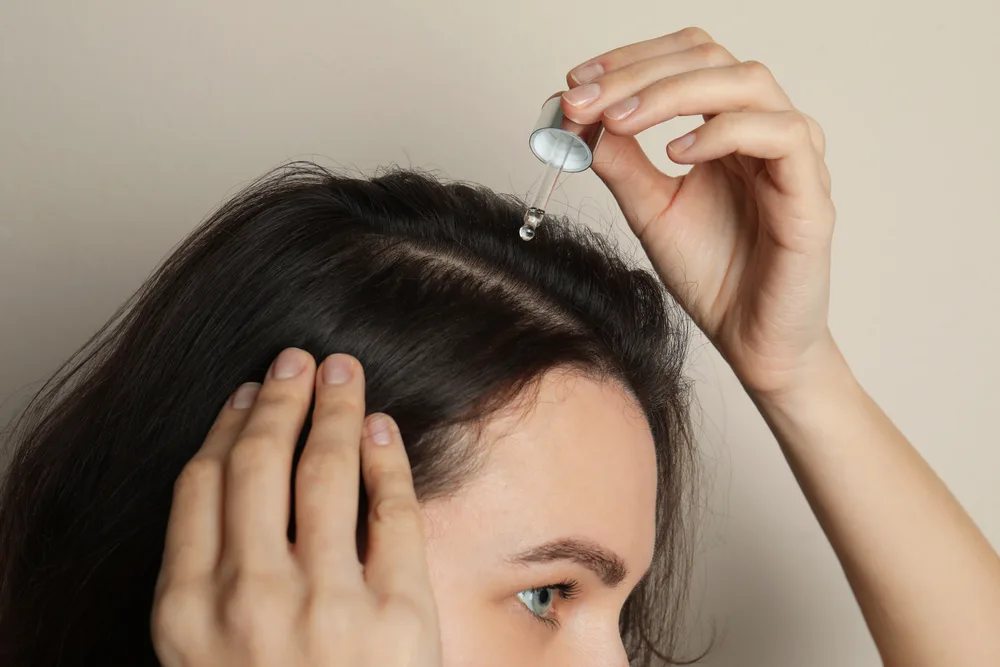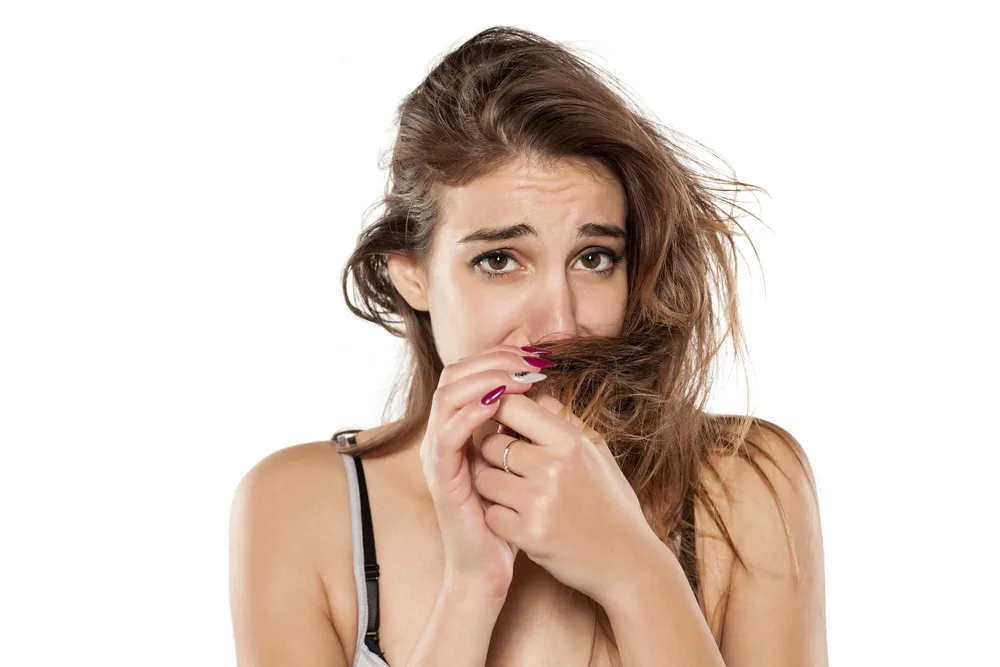Jump to:
Have you ever wondered, “can your hair get moldy?” If so, you might be surprised to know that hair can become susceptible to mildew growth when it is improperly cared for. Read on to learn how to identify the signs of mold in your hair and how to treat it.
What Is Moldy Hair?
If you’re having trouble keeping your hair in top condition, it might become susceptible to getting moldy. Mold is a fungal growth that thrives in moist conditions and forms from pores that attach to moist surfaces.
Although most people associate mold growth with spoiled food or damp ceilings, your hair can become the perfect breeding ground for this inconvenient fungus.
Besides making your hair look greasier and leaving large, discolored specks in your hair, mold growth can make your hair and scalp smell musty. Some types of fungus can cause dandruff and potential hair loss.
Factors that can cause moldy hair include:
- Overexposure to moisture
- A sweaty scalp
- Specific hairstyles that lock in moisture
If you or someone you know is allergic to mold or mildew pores that form in your hair, it can trigger several reactions, ranging in severity, depending on your sensitivity, such as:
- Skin irritation
- Nasal congestion
- Itchy or watery eyes
- Sneezing
- Coughing
- Breathing difficulties (shortness of breath or chest tightness)
- Dry skin
If you’re worried about your hair getting moldy, there are several ways you can remedy this issue and keep your hair healthy.
What Makes Your Hair Moldy?
Although moisture is a common cause of mildew and mold growth in your hair, specific scenarios are more likely to occur if you don’t take proper precautions to keep it from forming.
Overly-Moisturized Hair
Although moisturizing your hair and scalp is the best way to keep it from getting too dry or flaky, especially for natural hair, you can overdo it.
For instance, if you keep moisturizing it with hair cream or conditioner, you can distribute it unevenly across your hair and scalp, leaving some places damper than others.
Moisture Caused by a Sweaty Scalp
Another way moldy hair can get moisture to grow is through excessive sweating. Your pores’ sweat and natural oils can build up and grow mold in your hair if you don’t air it out or wash it away.
Your sweat can also strengthen the foul smell of moldy hair, make it extra itchy, and produce excess sebum if left untreated. If you don’t wash your hair, your scalp produces more oils, resulting in more mildew.
Hairstyles That Trap Moisture
Your hair is more likely to become moldy and smell if you style it in a bun or ponytail while moist or wet. These hairstyles trap moisture once you secure them, making it difficult to dry completely. Locs and thicker hair can also produce mold since it can take longer for it to air-dry, compared to flat or thin hair.
Improper Drying
Several people might not realize how essential drying their hair is when keeping it in top condition against mold. Removing its moisture can take a long time if you prefer air-drying your hair instead of using a towel or hair dryer.
Insufficient hair drying can become an issue if you prefer washing your hair at night since any leftover moisture you miss can become locked when your hair presses against your pillow while you sleep.
The Best Way to Treat or Prevent Moldy Hair

New Africa/Shutterstock
Although moldy hair sounds like a daunting obstacle to overcome, there are several ways you can manage it without becoming overwhelmed.
Wash Your Hair with Medicated or Anti-Fungal Shampoo
Clarifying or medicated shampoo is one effective treatment you should consider when your hair gets moldy. Shampoos rich in sulfates can break down the residue on your hair and scalp.
Remember how much shampoo you use when treating your hair, since sulfates can strip moisture from your hair. Through this process, you can prevent your hair from becoming too dry. If you prefer using anti-fungal shampoo to treat moldy hair, consider washing your hair with it every few days.
Be sure to check your hair and scalp carefully to ensure that every trace of the mold gets removed from your head. Don’t forget to check your shampoo’s pH level to ensure that it won’t damage your hair while removing moldy residue.
Read Next: The 7 Best Clarifying Shampoos in 2025
Treat Your Scalp With Essential Oils
Essential oils are an excellent remedy for anyone who prefers using something that won’t be too harsh on their hair and eliminating odors formed by moldy hair. For the best results, dilute it with water and let it rest on your hair and scalp for at least 30 minutes.
After cleansing your hair with essential oils, wash it with anti-fungal shampoo and conditioner. Then, dry your hair thoroughly after rinsing it out. Like most remedies, you might not see results overnight, so continue this process until every trace of mold gets removed.
Dry Your Hair Without Trapping Moisture
After washing your hair, use a towel to dry every part of your head. If you’re short on time, you can use a hair dryer to streamline this process. Leaving your hair loose can also help it dry out naturally for several hours.
Read Next: How to Plop Your Hair
Frequently Asked Questions

Vladimir Gjorgiev/Shutterstock
Are you still concerned about your hair getting moldy? Here are a few common questions about moldy hair and how to treat it.
How can I tell if I have mold or mildew in my hair?
Check your hair or scalp for gray, yellow, or white patches of fungal residue. Hair mold usually emits a foul odor, resulting in an inflamed fungal infection on your scalp.
Does sleeping with wet hair cause mold?
Moldy hair can result from wet hair pressing against your pillow as you sleep. Confining natural or curly wet hair in a scarf or bonnet overnight can also lock in its moisture and make it susceptible to mold growth.
How long does it take to get rid of mold?
The time it takes to fix moldy hair by washing it with anti-fungal or medicated shampoo can vary from person to person. It can take a few days or over a week, depending on how much you have.
What essential oils or home remedies work best against moldy hair?
Tea tree oil makes an effective topical treatment for moldy hair and reduces inflammation on your scalp for most hair types and textures.
Consider applying it to your hair and scalp before washing your hair every two or three days weekly for the best results. White vinegar, lavender, grapefruit seed oil, and lemon can also fight off most molds that can form in your hair.
Why is natural hair prone to getting moldy?
Since natural hair dries out more quickly, some people try to retain its moisture and volume or make it softer. However, over-moisturizing it without drying it thoroughly can make mold particles form from its dampness.
So, Can Your Hair Get Moldy?
Your hair can get moldy when exposed to high levels of moisture, such as not drying it entirely after washing your hair. Thankfully, there are several ways you can treat and prevent moldy hair that match your hair care routine.
These include using a medicated shampoo to remove fungal residue or drying your hair thoroughly before you go to bed. Consider trying many of these remedies if you ever encounter moldy hair issues. Your hair (and your partner) will thank you.
